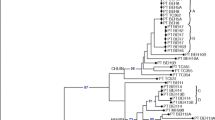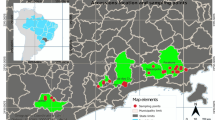Abstract
The Capsicum genus is native to tropical America and consists of 27 species, five of which are used as fresh vegetables and spices: Capsicum annuum L., Capsicum chinense Jacq., Capsicum frutescens L., Capsicum baccatum L. and Capsicum pubescens R. et P. The study of the relationships among species of cultivate Capsicum species will be useful for breeding new cultivars or hybrids. This study is focused on the genetic diversity and relationships of these species that were collected in the Andean region. Ten microsatellites and four AFLP combinations were used to characterize 260 Capsicum accessions. The AFLP tree turned out to be informative regarding relationships among species. The data clearly showed the close relationships between C. chinense and C. frutescens. Moreover, C. cardenasii and C. eximium were indistinguishable as a single, morphologically variable species. Our data showed C. baccatum and C. praetermissum to be distinct species that form a compact group. In the present work, AFLP fingerprinting indicated that C. chacoense was placed in the C. baccatum complex and showed C. tovarii as a separate species. In addition, SSR data indicated that there is intraspecific differentiation in the species C. chinense, C. baccatum and C. pubescens, as the PCoA-based clustering showed a clear geographic division related to country. Even though Bolivia is considered to be the nuclear area for these species, we have found similar variability in Ecuador and Peru for several Capsicum species.


Similar content being viewed by others
References
Aguilar-Melendez A, Morrell PL, Mikeal LR, Seung Chul K (2009) Genetic diversity and structure in semiwild and domesticated chiles (Capsicum annuum; Solanaceae) from Mexico. Am J Bot 96:1190–1202
Belkhir K, Borsa P, Chikhi L, Rafaste N, Bonhomme T (1996) Genetix 4.04 Logiciel sours Windous TM pour la genetique des populations. Laboratoire Génome, populations, interactions, Université de Montpellier II, Montpellier. Website http://www.genetix.univ-montp2.fr/genetix/genetix.htm
Benham J, Jeung JU, Jasieniuk M, Kanazin V, Blake T (1999) Genographer: a graphical tool for automated AFLP and microsatellite analysis. J Agric Genomics 4:3
Blanca JM, Prohens J, Anderson GJ, Zuriaga E, Canizares J, Nuez F (2007) AFLP and DNA sequence variation in an Andean domesticate, pepino (Solanum muricatum, Solanaceae): Implications for evolution and domestication. Am J Bot 94:1219–1229
Bornet B, Goraguer F, Joly G, Branchard M (2002) Genetic diversity in European and Argentinian cultivated potatoes (Solanum tuberosum subsp. tuberosum) detected by inter-simple sequence repeats (ISSRs). Genome 45:481–484
Bosland PW, Votava EJ (2000) Peppers: vegetable and spice capsicums. CAB International, Wallingford
Cavalli-Sforza LL, Edwards AWF (1967) Phylogenetic analysis: models and estimation procedures. Evolution 32:550–570
Choong CY (1998) DNA polymorphisms in the study of relationships and evolution in Capsicum. Ph.D. Thesis, University of Reading
Crosby KM (2008) Pepper. In: Prohens J, Nuez F, Carena MJ (eds) Vegetables II, 1st edn. Springer, New York, pp 221–248
De Swart EAM (2007) Potential for breeding sweet pepper adapted to cooler growing conditions. A physiological and genetic analysis of growth traits in Capsicum. Ph.D. Thesis, Wageningen University
DeWitt D, Bosland PW (1996) Peppers of the world: an identification guide. Ten Speed Press, Berkeley
Doyle JJ, Doyle JL (1990) Isolation of plant DNA from fresh tissue. Focus 12:13–15
Eshbaugh WH (1976) Genetic and biochemical systematic studies of chili peppers (Capsicum-Solanaceae). Bull Torrey Bot Club 102:396–403
Fery RL, Thies JA (1997) Evaluation of Capsicum chinense Jacq. cultigens for resistance to the southern root-knot nematode. Hortscience 32:923–926
Furini A, Wunder J (2004) Analysis of eggplant (Solanum melongena)-related germplasm: morphological and AFLP data contribute to phylogenetic interpretations and germplasm utilization. Theor Appl Genet 108:197–208
Geleta LF, Labuschagne MT, Viljoen CD (2005) Genetic variability in pepper (Capsicum annuum L.) estimated by morphological data and Amplified Fragment Length Polymorphism markers. Biodivers Conserv 14:2361–2375
Guzman FA, Ayala H, Azurdia C, Duque MC, de Vicente MC (2005) AFLP assessment of genetic diversity of Capsicum genetic resources in Guatemala: home gardens as an option for conservation. Crop Sci 45:363–370
Hanacek P, Vyhnanek T, Rohrer M, Cieslarova J, Stavelikova H (2009) DNA polymorphism in genetic resources of red pepper using microsatellite markers. Horticul Sci 36:127–132
Ibiza VP, Canizares J, Nuez F (2010) EcoTILLING in Capsicum species: searching for new virus resistances. BMC Genomics 11:631
Ince AG, Karaca M, Onus AN (2010) Genetic relationships within and between Capsicum species. Biochem Genet 48:83–95
Langella O (2002) Populations 1.2.28, population genetic software. CNRS Website http://www.bioinformatics.org/~tryphon/populations/
Lefebvre V, Goffinet B, Chauvet JC, Caromel B, Signoret P, Brand R, Palloix A (2001) Evaluation of genetic distances between pepper inbred lines for cultivar protection purposes: comparison of AFLP, RAPD and phenotypic data. Theor Appl Genet 102:741–750
Li YC, Korol AB, Fahima T, Nevo E (2004) Microsatellites within genes: structure, function, and evolution. Mol Biol Evol 21:991–1007
Loaiza-Figueroa F, Ritland K, Laborde-Cancino JA, Tanksley SD (1989) Patterns of genetic variation of the genus Capsicum (Solanaceae) in Mexico. Plant Syst Evol 165:159–188
Louette D, Charrier A, Berthaud J (1997) In situ conservation of maize in Mexico: genetic diversity and maize seed management in a traditional community. Econ Bot 51:20–38
McLeod MJ, Eshbaugh WH, Guttman SI (1979a) A pre-liminary biochemical systematic study of the genus Capsicum-Solanaceae. In: Hawkes JG, Lester RN, Skelding AD (eds) The biology and taxonomy of the Solanaceae. Academic Press, New York, pp 701–714
McLeod MJ, Eshbaugh WH, Guttman SI (1979b) Electrophoretic study of Capsicum (Solanaceae)—purple flowered taxa. Bull Torrey Bot Club 106:326–333
McLeod MJ, Guttman SI, Eshbaugh WH (1982) Early evolution of chili peppers (Capsicum). Econ Bot 36:361–368
McLeod MJ, Guttman SI, Eshbaugh WH, Rayle RE (1983) An electrophoretic study of evolution in Capsicum (Solanaceae). Evolution 37:562–574
Minamiyama Y, Tsuro M, Hirai M (2006) An SSR-based linkage map of Capsicum annuum. Mol Breed 18:157–169
Moscone EA, Baranyi M, Ebert I, Greilhuber J, Ehrendorfer F, Hunziker AT (2003) Analysis of nuclear DNA content in Capsicum (Solanaceae) by flow cytometry and Feulgen densitometry. Ann Bot 92:21–29
Moscone EA, Scaldaferro MA, Grabiele M, Cecchini NM, Garcia YS, Jarret R, Davina JR, Ducasse DA, Barboza GE, Ehrendorfer F (2007) The evolution of chili peppers (Capsicum—Solanaceae): a cytogenetic perspective. In: Proceedings of the VIth international Solanaceae conference. Solanaceae VI: Genomics Meets Biodiversity, pp 137–169
Nuez F, Gil R, Costa J (1996) El cultivo de pimientos, chiles y ajies. Mundi-Prensa, Madrid
Nuez F, Prohens J, Blanca JM (2004) Relationships origin, and diversity of Galapagos tomatoes: implications for the conservation of natural populations. Am J Bot 91:86–99
Onus AN, Pickersgill B (2004) Unilateral incompatibility in Capsicum (Solanaceae): occurrence and taxonomic distribution. Ann Bot 94:289–295
Pickersgill B (1971) Relationships between weedy and cultivated forms in some species of chili peppers (genus Capsicum). Evolution 25:683–691
Pickersgill B (1988) The genus Capsicum: a multidisciplinary approach to the taxonomy of cultivated and wild plants. Biologisches Zentralblatt 107:381–389
Pickersgill B (1991) Cytogenetics and evolution of Capsicum L. In: Tsuchiya T, Gupta PK (eds) Chromosome engineering in plants: genetics, breeding, evolution. Elsevier, Amsterdam, pp 139–160
Pickersgill B (2007) Domestication of plants in the Americas: insights from Mendelian and molecular genetics. Ann Bot 100:925–940
Polston JE, Cohen L, Sherwood TA, Ben-Joseph R, Lapidot M (2006) Capsicum species: symptomless hosts and reservoirs of Tomato yellow leaf curl virus. Phytopathology 96:447–452
Portis E, Nagy I, Sasvari Z, Stagel A, Barchi L, Lanteri S (2007) The design of Capsicum spp. SSR assays via analysis of in silico DNA sequence, and their potential utility for genetic mapping. Plant Sci 172:640–648
R Development Core Team (2007) R: a language and environment for statistical computing. R Foundation for Statistical Computing, Vienna, Austria. Website http://www.r-project.org/
Rodriguez JM, Berke T, Engle L, Nienhuis J (1999) Variation among and within Capsicum species revealed by RAPD markers. Theor Appl Genet 99:147–156
Ryzhova NN, Kochieva EZ (2004) Analysis of microsatellite loci of the chloroplast genome in the genus Capsicum (pepper). Russian J Genet 40:892–896
Sifres A, Blanca J, Nuez F (2010) Pattern of genetic variability of Solanum habrochaites in its natural area of distribution. Genet Resour Crop Evol. doi:10.1007/s10722-010-9578-0
Spooner DM, McLean K, Ramsay G, Waugh R, Bryan GJ (2005) A single domestication for potato based on multilocus amplified fragment length polymorphism genotyping. Proc Natl Acad Sci USA 102:14694–14699
Sudre CP, Goncalves LSA, Rodrigues R, do Amaral AT, Riva-Souza EM, Bento CD (2010) Genetic variability in domesticated Capsicum spp. as assessed by morphological and agronomic data in mixed statistical analysis. Genet Mol Res 9:283–294
Tam SM, Lefebvre V, Palloix A, Sage-Palloix AM, Mhiri C, Grandbastien MA (2009) LTR-retrotransposons Tnt1 and T135 markers reveal genetic diversity and evolutionary relationships of domesticated peppers. Theor Appl Genet 119:973–989
Tong N, Bosland PW (1999) Capsicum tovarii, a new member of the Capsicum baccatum complex. Euphytica 109:71–77
Toquica SP, Rodriguez F, Martinez E, Duque MC, Tohme J (2003) Molecular characterization by AFLPs of Capsicum germplasm from the Amazon Department in Colombia, characterization by AFLPs of Capsicum. Genet Resour Crop Evol 50:639–647
Walsh BM, Hoot SB (2001) Phylogenetic relationships of Capsicum (Solanaceae) using DNA sequences from two noncoding regions: the chloroplast atpB-rbcL spacer region and nuclear waxy introns. Int J Plant Sci 162:1409–1418
Yoon JB, Yang DC, Do JW, Park HG (2006) Overcoming two post-fertilization genetic barriers in interspecific hybridization between Capsicum annuum and Capsicum baccatum for introgression of anthracnose resistance. Breeding Sci 56:31–38
Zewdie Y, Bosland PW (2000) Capsaicinoid inheritance in an interspecific hybridization of Capsicum annuum × C. chinense. J Am Soc Hortic Sci 125:448–453
Zijlstra S, Purimahu AC, Lindhout P (1991) Pollen tube growth in interspecific crosses between Capsicum species. HortScience 26:585–586
Zuriaga E, Blanca J, Nuez F (2009a) Classification and phylogenetic relationships in Solanum section Lycopersicon based on AFLP and two nuclear gene sequences. Genet Resour Crop Evol 56:663–678
Zuriaga E, Blanca JM, Cordero L, Sifres A, Blas-Cerdan WG, Morales R, Nuez F (2009b) Genetic and bioclimatic variation in Solanum pimpinellifolium. Genet Resour Crop Evol 56:39–51
Acknowledgments
VPI is the recipient of an FPU fellowship of the Ministerio de Educación y Ciencia. We want to recognize the invaluable task carried out by the Instituto de Conservación y Mejora de la Agrodiversidad Valenciana (COMAV, Spain), the Universidad Nacional de Loja (UNL, Ecuador), the Universidad Nacional de Piura (UNP, Peru), the Universidad Nacional Agraria La Molina (UNAM, Peru), the Universidad Nacional de Trujillo (UNT, Peru), the Universidad Nacional Pedro Ruiz Gallo (UNPRG, Peru), the Universidad Mayor de San Simón (UMSS, Bolivia), the United States Department of Agriculture (USDA, USA), the Center for Genetic Resources (CGN, The Netherlands) and the Radboud University of Nijmegen (RUN, The Netherlands), which provided important accessions. The help of Joshua Bergen in improving the English of this manuscript is gratefully acknowledged.
Author information
Authors and Affiliations
Corresponding author
Electronic supplementary material
Below is the link to the electronic supplementary material.
Rights and permissions
About this article
Cite this article
Ibiza, V.P., Blanca, J., Cañizares, J. et al. Taxonomy and genetic diversity of domesticated Capsicum species in the Andean region. Genet Resour Crop Evol 59, 1077–1088 (2012). https://doi.org/10.1007/s10722-011-9744-z
Received:
Accepted:
Published:
Issue Date:
DOI: https://doi.org/10.1007/s10722-011-9744-z




